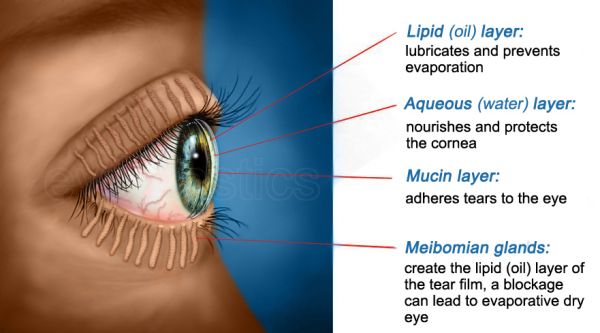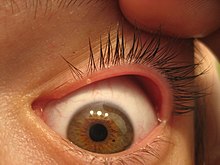Blepharitis
Blepharitis
- is an ocular condition characterized by chronic inflammation of the eyelid, the severity and time course of which can vary. It can onset acutely resolving without treatment within 2–4 weeks (this can be greatly reduced with lid hygiene) but more generally is a long standing inflammation varying in severity.
Signs and symptoms

Signs and symptoms that are associated with the chronic inflammation can be;
- Redness of the eyelids.
- Flaking of skin on the lids.
- Crusting at the lid margins, this is generally worst on waking.
- Cysts at the lid margin (hordeolum).
- Red eye.
- Debris in the tear film, seen under magnification (improved contrast with use of fluorescein drops).
- Gritty sensation of the eye.
- Reduced vision.
Common signs and symptoms of blepharitis also include itching, irritation and burning as well as a foreign body sensation. Some patients experience eye dryness, which can cause a certain degree of discomfort.
Blepharitis that localizes in the skin of the eyelids might possibly cause styes or chalazia, which appear like red bumps, often with a yellow spot if infection is present. Although pain is not common among blepharitis symptoms, if the condition persists or becomes painful, the individual is recommended to seek medical attention.
Chronic blepharitis might possibly lead to in damage of varying severity which might possibly have a negative effect upon vision and therefore upon the eyeglass prescription.
Infectious blepharitis can cause hard crusts around the eyelashes which leave small ulcers that might possibly bleed or ooze after cleaning.
As a general rule, blepharitis whose symptoms do not improve despite good hygiene consisting of proper cleaning and care of the eye area, should be referred to a doctor.

Staphylococcal blepharitis
Staphlycoccal blepharitis is caused by infection of the anterior portion of the eyelid by Staphylococcal bacteria. As the infection progresses, the sufferer might possibly begin to notice a foreign body sensation, matting of the lashes, and burning. Usually, the primary care physician will prescribe topical antibiotics for staphylococcal blepharitis, as this is an acute condition and should heal quickly. The condition can often lead to a chalazion or a stye.
Staphylococcal blepharitis is a more severe condition which might possibly start in childhood and continue through adulthood. It is commonly recurrent and it requires special medical care. The prevalence of Staphylococcus aureus in the conjunctival sac and on the lid margin varies among countries, apparently according to climate.
In cases of blepharitis caused by Staphylococcus aureus, the presence of a collarette (a ring-like formation around the lash shaft) can be observed. This is the main sign of this particular condition. Other specific symptoms include loss of eyelashes or broken eyelashes.
Staphylococcal blepharitis is mainly diagnosed upon the patient's medical history and a bacterial culture. However, since blepharitis is a condition that is completely understood, diagnosis usually consists of establishing an accurate medical history of the patient and a proper physical examination. Blepharitis is diagnosed primarily upon physical examination and rarely further tests are needed. Yet, it is recommended that older patients or those who are at risk of developing certain skin conditions undergo biopsy in order to remove the possibility of tumor.
This type of blepharitis is more likely to occur in individuals who are exposed to bacteria. Staphylococcal blepharitis, unlike the other types of this condition, seems to be seen more commonly in women than in men.
It is important that this type of blepharitis is suitably treated because otherwise the infection might possibly spread to other parts of the eye or to the scarring of the cornea. Staphylococcal blepharitis is normally treated with antibiotics such as Chloramphenicol ointment. Fusidic acid is usually the choice of antibiotics in cases when Chloramphenicol is contraindicated. Antibiotics are given for at least four weeks and up to six weeks, which is considered enough so the infection is completely cured. Also, blepharitis treatment includes a short cure of topical steroids which are administered to control the inflammation.
Staphylococcal blepharitis, along with the other types of blepharitis treatment is only effective if given at the same time with extra cautious eyelid hygiene. This consists of eyelid proper cleaning and removing crusts and debris and maintaining the hygiene by avoiding expired make up or cosmetics that are used around the eye. Particularly in blepharitis caused by S. aureus, patients are recommended to keep the eyelids area clean to avoid spreading the infection when oozing and bleeding occurs.
Posterior blepharitis or rosacea-associated blepharitis

The most common type of blepharitis is often found in people with a Rosacea skin type. The oil glands in the lid of rosacea sufferers secrete a modified oil which leads to inflammation at the meibomian gland openings which are found at the edge of the lid


![This image depicts [describe the objects and embedded text here].](/public/images/gallery/thumb_images/getpicture21276689942.jpg)




